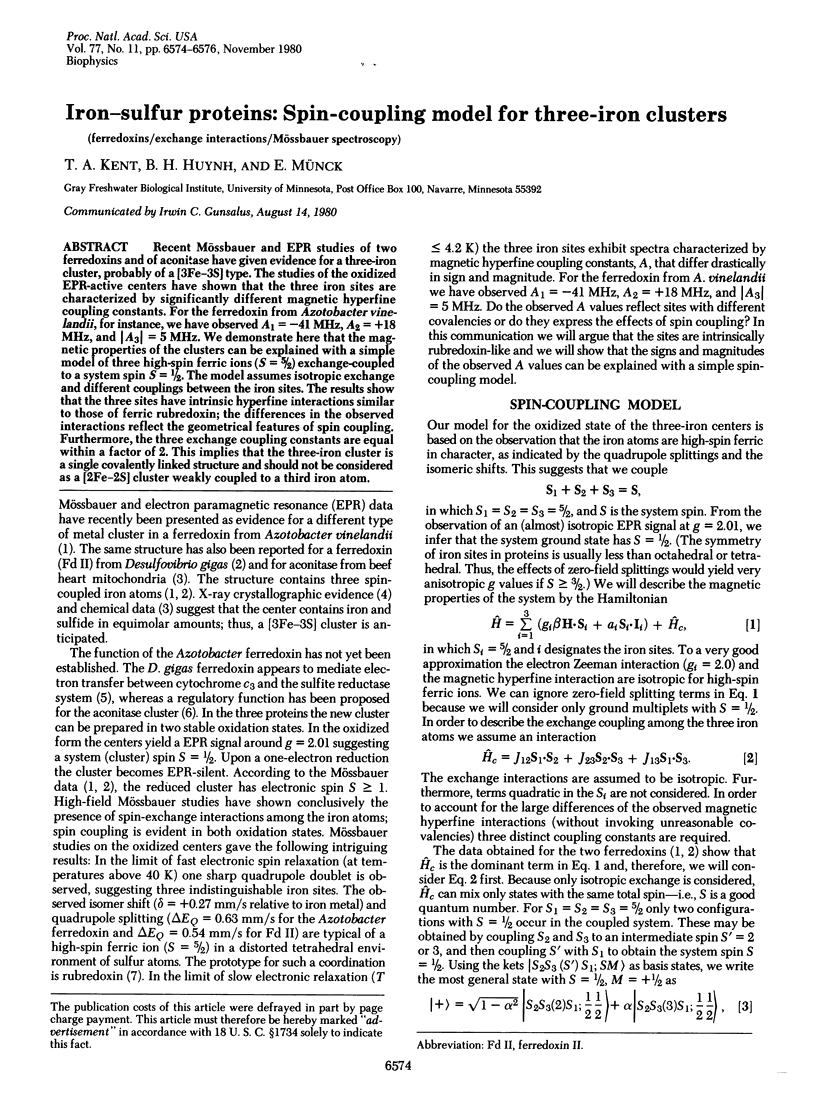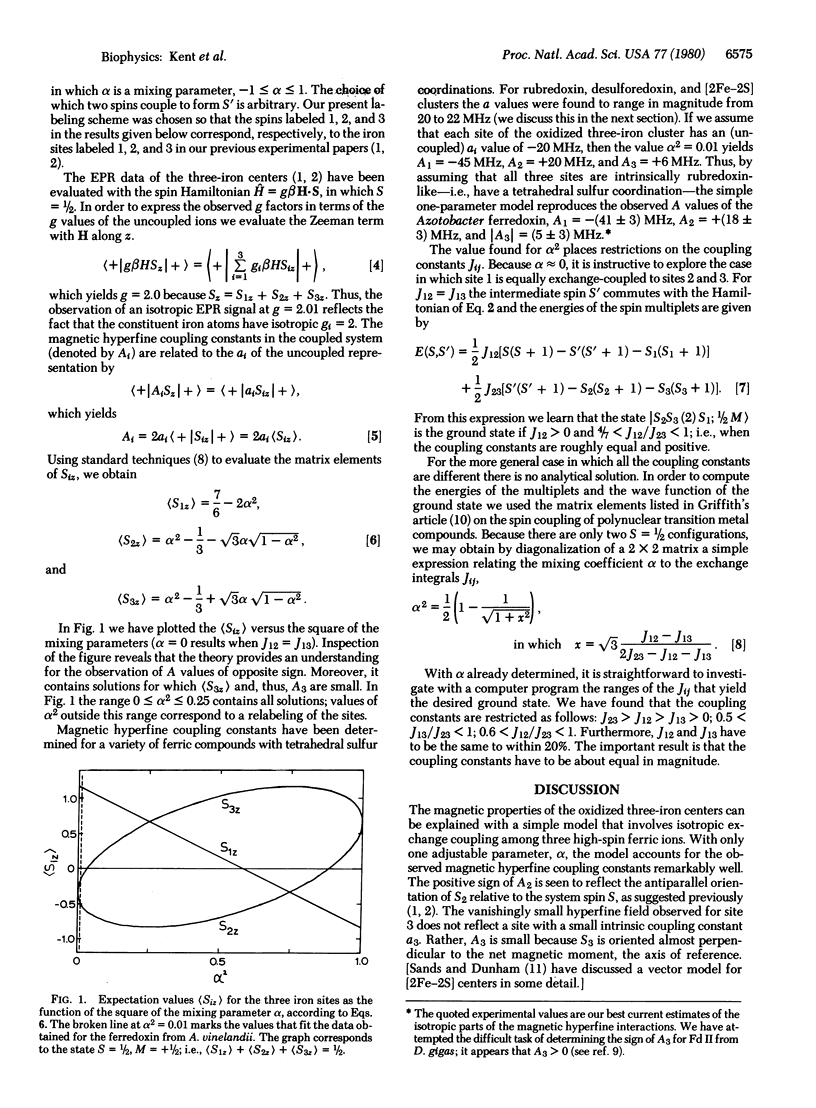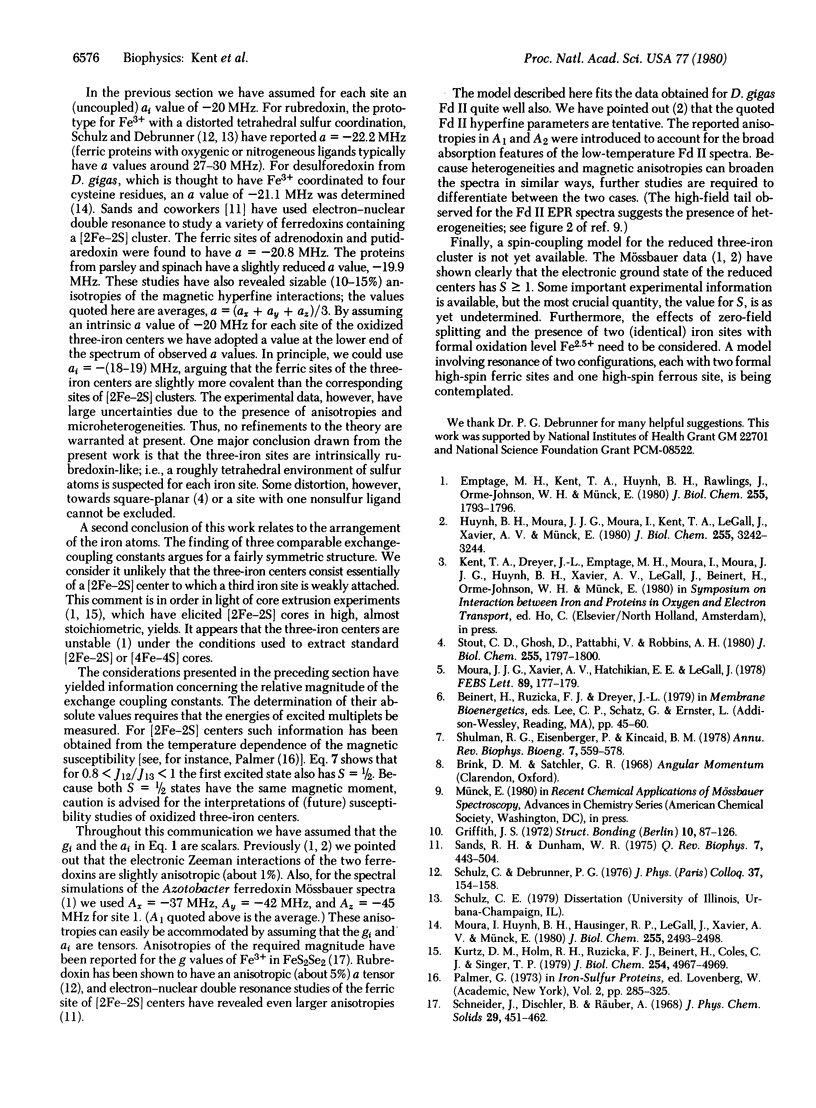Abstract
Recent Mössbauer and EPR studies of two ferredoxins and of aconitase have given evidence for a three-iron cluster, probably of a [3Fe-3S] type. The studies of the oxidized EPR-active centers have shown that the three iron sites are characterized by significantly different magnetic hyperfine coupling constants. For the ferredoxin from Azotobacter vinelandii, for instance, we have observed A1 = -41 MHz, A2 = +18 MHz, and [A3] = 5 MHz. We demonstrate here that the magnetic properties of the clusters can be explained with a simple model of three high-spin ferric ions (S = 5/2) exchange-coupled to a system spin S = 1/2. The model assumes isotropic exchange and different couplings between the iron sites. The results show that the three sites have intrinsic hyperfine interactions similar to those of ferric rubredoxin; the differences in the observed interactions reflect the geometrical features of spin coupling. Furthermore, the three exchange coupling constants are equal within a factor of 2. This implies that the three-iron cluster is a single covalently linked structure and should not be considered as a [2Fe-2S] cluster weakly coupled to a third iron atom.
Full text
PDF


Selected References
These references are in PubMed. This may not be the complete list of references from this article.
- Emptage M. H., Kent T. A., Huynh B. H., Rawlings J., Orme-Johnson W. H., Münck E. On the nature of the iron-sulfur centers in a ferredoxin from Azotobacter vinelandii. Mössbauer studies and cluster displacement experiments. J Biol Chem. 1980 Mar 10;255(5):1793–1796. [PubMed] [Google Scholar]
- Huynh B. H., Moura J. J., Moura I., Kent T. A., LeGall J., Xavier A. V., Münck E. Evidence for a three-iron center in a ferredoxin from Desulfovibrio gigas. Mössbauer and EPR studies. J Biol Chem. 1980 Apr 25;255(8):3242–3244. [PubMed] [Google Scholar]
- Kurtz D. M., Holm R. H., Ruzicka F. J., Beinert H., Coles C. J., Singer T. P. The high potential iron-sulfur cluster of aconitase is a binuclear iron-sulfur cluster. J Biol Chem. 1979 Jun 25;254(12):4967–4969. [PubMed] [Google Scholar]
- Moura I., Huynh B. H., Hausinger R. P., Le Gall J., Xavier A. V., Münck E. Mössbauer and EPR studies of desulforedoxin from Desulfovibrio gigas. J Biol Chem. 1980 Mar 25;255(6):2493–2498. [PubMed] [Google Scholar]
- Moura J. J., Xavier A. V., Hatchikian E. C., Le Gall J. Structural control of the redox potentials and of the physiological activity by oligomerization of ferredoxin. FEBS Lett. 1978 May 1;89(1):177–179. doi: 10.1016/0014-5793(78)80549-3. [DOI] [PubMed] [Google Scholar]
- Sands R. H., Dunham W. R. Spectroscopic studies on two-iron ferredoxins. Q Rev Biophys. 1974 Nov;7(4):443–504. doi: 10.1017/s0033583500001517. [DOI] [PubMed] [Google Scholar]
- Shulman R. G., Eisenberger P., Kincaid B. M. X-ray absorption spectroscopy of biological molecules. Annu Rev Biophys Bioeng. 1978;7:559–578. doi: 10.1146/annurev.bb.07.060178.003015. [DOI] [PubMed] [Google Scholar]
- Stout C. D., Ghosh D., Pattabhi V., Robbins A. H. Iron-sulfur clusters in Azotobacter ferredoxin at 2.5 A resolution. J Biol Chem. 1980 Mar 10;255(5):1797–1800. [PubMed] [Google Scholar]


